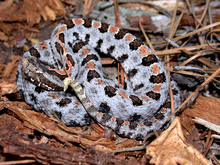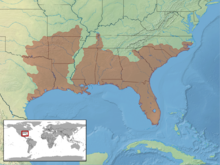Sistrurus miliarius
| Sistrurus miliarius | |
|---|---|
 |
|
| Scientific classification | |
| Kingdom: | Animalia |
| Phylum: | Chordata |
| Class: | Reptilia |
| Order: | Squamata |
| Suborder: | Serpentes |
| Family: | Viperidae |
| Genus: | Sistrurus |
| Species: | S. miliarius |
| Binomial name | |
|
Sistrurus miliarius (Linnaeus, 1766) |
|
 |
|
| Synonyms | |
|
|
Sistrurus miliarius is a venomous pit viper species found in the southeastern United States. Three subspecies are currently recognized including the nominate subspecies described here.
A small species with adults usually growing to 40–60 cm (16–24 in) in length. Maximum reported length are 78.8 cm (31.0 in) (Klauber, 1972). Snellings and Collins (1997) reported a specimen of S. m. barbouri measuring 80.3 cm (31.6 in), but it had been in captivity for over 12 years. The largest S. m. barbouri reported by Gloyd (1940) was a specimen measuring 63.8 cm (25.1 in) from St. Petersburg, Florida. Shine (1978) suggested that in some populations males may be larger than females, but a later study by Bishop et al. (1996) did not find sexual dimorphism of any kind in a population in Volusia County, Florida.
The midbody rows of dorsal scales usually number 23. The dorsal pattern consists of a series of oval or subcircular spots with reasonably regular edges. The spots on the flanks are mostly round and not much higher than they are wide. Belly pigmentation towards the rear is more limited to indistinct blotches found on pairs of adjacent scales. Juveniles have a color pattern that is similar to the adults, although it may be paler or more vividly marked, and the tip of the tail is yellow.
Bastard rattlesnake, nipple snake, Carolina ground rattlesnake, brick red rattlesnake, Carolina pygmy rattlesnake, Catesby's small snake, dwarf rattlesnake, eastern pygmy rattlesnake, grey rattlesnake, ground rattler (Garman, 1887), ground rattlesnake, hog-nosed rattlesnake, little rattlesnake, miliar(y) rattlesnake, North American smaller rattlesnake, oak-leaf rattler, pygmy ground rattlesnake, pygmy rattlesnake, small rattlesnake, southeastern ground rattlesnake, southern ground rattlesnake, southern pygmy rattlesnake, spotted rattler, spotted rattlesnake, southern rattlesnake.
Found in the southeastern United States from southern and eastern North Carolina, south through peninsular Florida and west to eastern Texas and Oklahoma. The type locality given is "Carolina." Schmidt (1953) proposed that this be restricted to "Charleston, South Carolina."
...
Wikipedia

